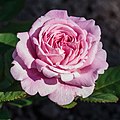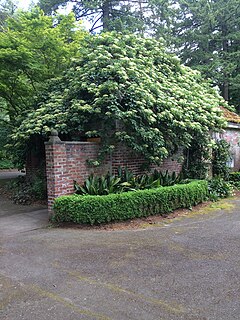
The International Rose Test Garden is a rose garden in Washington Park in Portland, Oregon, United States. There are over 10,000 rose bushes of approximately 650 varieties. The roses bloom from April through October with the peak coming in June, depending on the weather. New rose cultivars are continually sent to the garden from many parts of the world and are evaluated on several characteristics, including disease resistance, bloom formation, color, and fragrance. It is the oldest continuously operating public rose test garden in the United States and exemplifies Portland's nickname, "City of Roses". The garden draws an estimated 700,000 visitors annually.

David Charles Henshaw Austin was a British rose breeder and writer who lived in Shropshire, England. His emphasis was on breeding roses with the character and fragrance of old garden roses but with the repeat-flowering ability and wide colour range of modern roses such as hybrid teas and floribundas.

The Royal National Rose Society Gardens, also known as The Gardens of The Rose, were the gardens and headquarters of The Royal National Rose Society at Bone Hill, Chiswell Green, St Albans, Hertfordshire in the United Kingdom. The Royal National Rose Society was established in 1876 and the gardens were opened over 50 years ago by Mary, Princess Royal who was a Patron of the society at the time. The Society's stated aim was to create a "living dictionary" of roses. The gardens contain 2,500 different rose cultivars among 15,000 rose bushes.
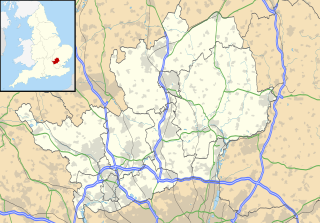
Chiswell Green is a village, to the south of St Albans, in the parish of St Stephen and district of City of St Albans in Hertfordshire. It has a population of approximately 2,800. It is in the civil parish of St. Stephen.

Rosa'KORbin' is a white floribunda rose cultivar bred by Kordes in Germany in 1958. It is also known as Iceberg, Fée des Neiges and Schneewittchen. 'KORbin' is among the world's best known roses.

A rose garden or rosarium is a garden or park, often open to the public, used to present and grow various types of garden roses, and sometimes rose species. Most often it is a section of a larger garden. Designs vary tremendously and roses may be displayed alongside other plants or grouped by individual variety, colour or class in rose beds. Technically it is a specialized type of shrub garden, but normally treated as a type of flower garden, if only because its origins in Europe go back to at least the Middle Ages in Europe, when roses were effectively the largest and most popular flowers, already existing in numerous garden cultivars.

Ellen Ann Willmott was an English horticulturist. She was an influential member of the Royal Horticultural Society, and a recipient of the first Victoria Medal of Honour, awarded to British horticulturists living in the UK by the society, in 1897. Willmott was said to have cultivated more than 100,000 species and cultivars of plants and sponsored expeditions to discover new species. Inherited wealth allowed Willmott to buy large gardens in France and Italy to add to the garden at her home, Warley Place in Essex. More than 60 plants have been named after her or her home, Warley Place.

The Butterfly World Project was a visitor attraction in the village of Chiswell Green, on the outskirts of St Albans in Hertfordshire, UK, dedicated to showcasing and promoting learning about butterflies. It closed permanently in 2015.
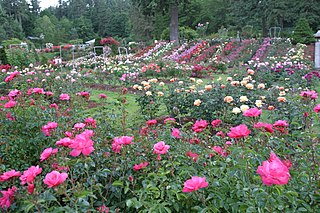
Rose trial grounds or rose test gardens are agricultural areas where garden roses are grown to be assessed for qualities such as health, floriferousness, novelty, and scent.

A rose show is a horticultural exhibition focusing exclusively on roses.

Henry Bennett (1823–1890) was a British pioneer in the systematic, deliberate hybridisation of roses. The tenant farmer from Stapleford in the Wylye Valley near Salisbury, Wiltshire applied the systematic breeding used in raising cattle to roses, and emphasised that his roses were raised scientifically from known parents. His hybrids, between Teas and Hybrid Perpetuals, were called Pedigree Hybrids of the Tea Rose. He is considered the father of the Hybrid Tea class. Important cultivars are the Hybrid Tea 'Lady Mary Fitzwilliam' (1882), a parent of 'Mme. Caroline Testout' and the Hybrid Perpetuals 'Captain Hayward' (1893) and 'Mrs. John Laing' (1887).
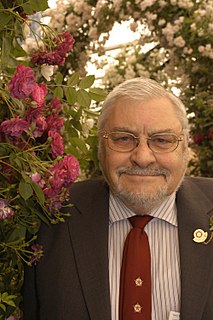
Peter Beales MBE, was a British rosarian, author and lecturer. Beales was considered one of the leading experts on roses, especially species and classic roses, preserving many old varieties and introducing 70 new cultivars during his lifetime. He served as the President of the Royal National Rose Society from 2003 until 2005. Speaking of his contribution on BBC news, Alan Titchmarsh said: "It was the old and classic roses that Peter loved best and by growing them and making them available to a wider range of gardeners, he did tremendous work in terms of our rose-growing heritage."

Walter Van Fleet was an American physician, horticulturalist, botanist, ornithologist and all around naturalist.
The Portland Gold Award is given annually by the Portland Rose Society to new rose cultivars that demonstrate exceptional performance in the Pacific Northwest of the United States. The first award was given in 1919 by the city of Portland, Oregon.
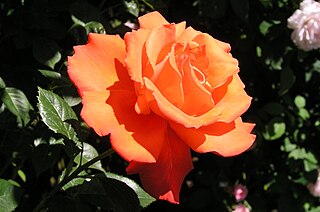
Rosa 'Alexander' is an orange-red hybrid tea rose. The cultivar was bred by Jack Harkness and introduced into Great Britain in 1972 by R. Harkness Roses & Co, Ltd. It has been awarded the Award of Garden Merit (AGM) by the Royal National Rose Society (RNRS) in 1993.

Rosa 'Frensham' is a dark red Floribunda rose cultivar, developed by Albert Norman in 1942 and introduced into Britain by Harkness Roses in 1946 as 'Frensham'. It was awarded the RNRS Gold Medal by the Royal National Rose Society (RNRS) in 1943.

Rosa 'Ena Harkness' is a medium red hybrid tea rose cultivar, developed by Albert Norman before 1940 and introduced into Britain by Harkness Roses in 1946. It was awarded the RNRS Gold Medal by the Royal National Rose Society (RNRS) in 1945 and the Portland Gold Medal in 1955.

Rosa 'Margaret McGredy' is an orange-red hybrid tea rose, bred by Irish rose breeder Sam McGredy III before 1925. The new rose was awarded the Royal National Rose Society (RNRS) Gold Medal in 1925, but was never commercially successful. 'Margaret McGredy, along with an unnamed seedling, was used to hybridize the legendary hybrid tea rose, 'Peace'.

Rosa 'Charles P. Kilham' is an orange-red hybrid tea rose, bred by Irish rose breeder, Samuel McGredy III before 1926. The rose was introduced in France in 1926 and Australia in 1927. It won the Royal National Rose Society (RNRS) gold medal in 1927. 'Charles P. Kilham' is one of the ancestors of the legendary hybrid tea rose, 'Peace'.






















